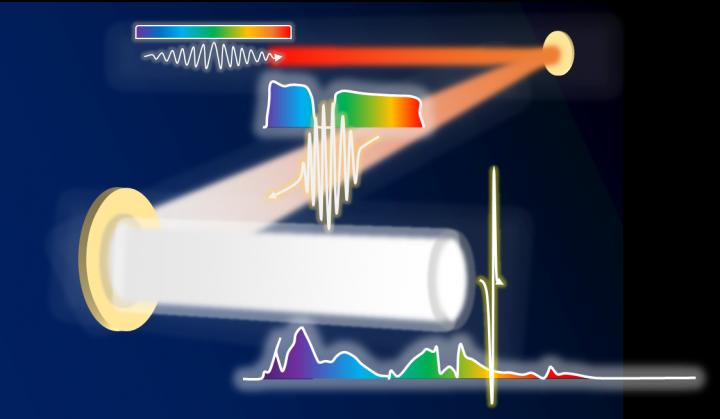Researchers from Osaka University propose a concept for next-generation ultra-intense lasers, possibly increasing the current record from 10 Petawatts to 500 Petawatts

Credit: Osaka University
Osaka, Japan — Ultra-intense lasers with ultra-short pulses and ultra-high energies are powerful tools for exploring unknowns in physics, cosmology, material science, etc. With the help of the famous technology “Chirped Pulse Amplification (CPA)” (2018 Nobel Prize in Physics), the current record has reached 10 Petawatts (or 10^16 Watts). In a study recently published in Scientific Reports, researchers from Osaka University proposed a concept for next-generation ultra-intense lasers with a simulated peak power up to the Exawatt class (1 Exawatt equals 1000 Petawatts).
The laser, which was invented by Dr. T. H. Maiman in 1960, has one important characteristic of high intensity (or high peak power for pulse lasers): historically, laser peak power has experienced two-stage development. Just after the birth of the laser, Q-switching and mode-locking technologies increased laser peak power to Kilowatt (10^3 Watt) and Gigawatt (10^9 Watt) levels. After CPA technology was invented by Gérard Mourou and Donna Strickland in 1985, by which material damage and optical nonlinearity were avoided, laser peak power was dramatically increased to Terawatt (10^12 Watt) and Petawatt (10^15 Watt) levels. Today, two 10-Petawatt CPA lasers have been demonstrated in Europe (ELI-NP laser) and China (SULF laser), respectively.
At present, the facility scale of Petawatt lasers around the world is very large and project investment is also very high. The next step for future ultra-intense lasers is to further increase the peak power by compressing the pulse duration instead of increasing the pulse energy.
In their previous study (OSA Continuum, DOI: 10.1364/OSAC.2.001125), this group developed a new design, “Wide-angle Non-collinear Optical Parametric Chirped Pulse Amplification (WNOPCPA),” to increase the amplified spectrum and accordingly reduce the compressed pulse. The key mechanism of WNOPCPA is to increase the overall bandwidth by using a multiple-beam pump, which corresponds to different amplified spectra. “However, the pump interference, in addition to induced possible damage, is a potential problem in applying WNOPCPA to a huge project,” explains corresponding author Zhaoyang Li.
In this newly improved design, by using a two-beam pumped WNOPCPA and carefully optimized phase-matching, pump interference is completely avoided, and an ultra-broadband bandwidth with two broad spectra is accomplished, resulting in
“This design has two advantages: one is ultra-broadband amplification in WNOPCPA and the other is enhancement of nonlinear spectral broadening in post-compression. This research may provide a possible way to further increase laser peak power, even up to the Exawatt class,” says Zhaoyang Li.
###
The article, “Simulating an ultra-broadband concept for Exawatt-class lasers,” was published in Scientific Reports at DOI: https:/
About Osaka University
Osaka University was founded in 1931 as one of the seven imperial universities of Japan and is now one of Japan’s leading comprehensive universities with a broad disciplinary spectrum. This strength is coupled with a singular drive for innovation that extends throughout the scientific process, from fundamental research to the creation of applied technology with positive economic impacts. Its commitment to innovation has been recognized in Japan and around the world, being named Japan’s most innovative university in 2015 (Reuters 2015 Top 100) and one of the most innovative institutions in the world in 2017 (Innovative Universities and the Nature Index Innovation 2017). Now, Osaka University is leveraging its role as a Designated National University Corporation selected by the Ministry of Education, Culture, Sports, Science and Technology to contribute to innovation for human welfare, sustainable development of society, and social transformation.
Website: https:/
Media Contact
Saori Obayashi
[email protected]
Original Source
https:/
Related Journal Article
http://dx.



